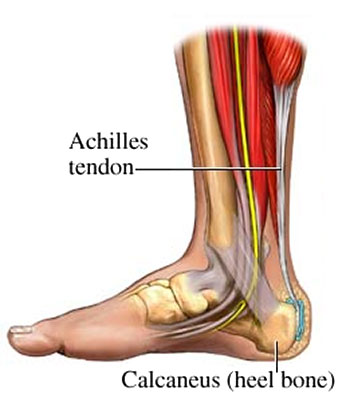How does achilles tendinopathy happen?

Achilles tendinopathy is a common injury in sports involving running and jumping, and results from overuse of the tendon.
The function of the Achilles tendon is to transmit forces produced by the calf muscles to the heel bone. Repetitive use of the calf muscles and, therefore, the Achilles tendon can lead to microscopic tears within the substance of the tendon. To repair these microscopic tears, the body commences an inflammatory response. Although this response is initially part of the healing process, when the stresses are repeated, the inflammation is prolonged and so produces local tissue damage.
Factors which may contribute to Achilles tendinopathy include a recent change in training (including frequency, duration, intensity and training surfaces), reduced rest times, biomechanical abnormalities, poor footwear and decreased muscle flexibility and joint range of motion. These factors can lead to increased stress on the Achilles tendon, microtears and subsequent tendinopathy.
How does it feel to have achilles tendinopathy?
Achilles tendinopathy results in pain within the tendon just above where it attaches to the heel bone. This pain typically develops gradually. Initially, the tendon may only be painful following exercise. For example, it may be felt on rising the day following participation. Associated with the pain may be stiffness or tightness in the Achilles region.
Typically, these initial signs of Achilles tendinopathy disappear quickly with walking about or applying heat (i.e. a hot shower) over the Achilles region. However, as you continue to participate, the tendinopathy progresses and the pain within the tendon becomes intense and more frequent. For example, it may begin to be present during participation. In the earlier stages, this pain during participation may initially disappear as you warm up, only to return when you cool down. However, as you continue to participate, the tendinopathy worsens and your pain may begin to be present for longer periods during participation until it is present all of the time. This may interfere with your performance.
What should I do if I have achilles tendinopathy?
Achilles tendinopathy generally does not settle without assessment and medical care. If you have or suspect you have Achilles tendinopathy, you should consult your nearest sports medicine professional. In the meantime, you can begin initial treatment. This should consist of icing following participation and regular calf stretching. Icing may consist of crushed ice wrapped in a moist towel applied for 15-20 minutes or ice in a paper cup massaged up and down over the Achilles region until the skin is numb.
What shouldn’t you do if you have achilles tendinopathy?
If you have or suspect you have Achilles tendon tendinopathy, you shouldn’t ignore the problem. Your pain may get better as you exercise; however, the exercise you are doing may be interfering with the healing process and causing further damage. This can lead to your injury getting worse such that your pain does not ‘warm up’ and you feel it throughout participation. If this occurs, your recovery may be prolonged and it may take a number of months for you to return to full participation.
Management of achilles tendinopathy
The assistance of a sports medicine professional is important in the treatment of Achilles tendinopathy. Initially, they can assist in diagnosing the problem and establishing its severity. This may require the use of imaging techniques such as ultrasound or MRI. From this, the sports medicine professional will determine an appropriate treatment plan. This involves activity modification, correction of your biomechanics using orthoses, and the progression through a series of specific strengthening exercises. Anti-inflammatory medication may be needed in some cases. Local cortisone injection is generally not advised. Injections of an irritant solution (prolotherapy) or your own blood (autologous blood injections or platelet rich plasma) are helpful in chronic cases.
Want specific advice for your individual situation?
Make an appointment today on (07) 3846 4800.
Suite 2B, 90 Vulture Street, West End, Queensland 4101
© 2009- Performance Podiatry and Physiotherapy Brisbane | Privacy Policy | Disclaimer | Website design:
